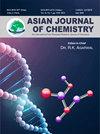基于喹啉的一系列新手性试剂的合成及其在液相色谱法分离外消旋麦西来汀中的应用,以及利用分子模型确认结果;一项完整的研究
Q4 Chemistry
引用次数: 0
摘要
在本研究中,通过引入疏水基团,制备了基于 L-缬氨酸的新手性衍生物。所制备的衍生物在温和的酰胺化反应和酯化反应中用于制备喹啉基手性试剂。利用光谱技术,如 HRMS、FT-IR、1H NMR 和 CHNS 分析,对合成的手性试剂进行了表征。合成的系列试剂随后被用于衍生外消旋甲氧苄啶的非对映异构体,并使用 RP-HPLC 对这些非对映异构体进行分离(一种衍生对映体分离方法)。分析的流动相由乙腈和缓冲溶液组成。优化了流动相 pH 值和浓度对分离非对映异构体的影响。通过使用密度泛函理论(DFT)计算,还开发出了能量最低的优化非对映异构体结构,以及分离过程和洗脱顺序的设计。根据 ICH 指南,确定了检测限(0.161 纳克/毫升)和定量限(0.483 纳克/毫升),以及保留因子 (k)、选择性因子 (α)、分辨率因子 (RS) 和技术验证。本文章由计算机程序翻译,如有差异,请以英文原文为准。
Synthesis of a Series of Quinoline-Based New Chiral Reagent and its Application in Separation of Racemic Mexiletine followed by Liquid Chromatography and Confirmation of Results Using Molecular Modelling; A Complete Study
In present work, L-valine-based new chiral derivatives were prepared by introducing hydrophobic groups. The prepared derivatives were then used to prepare quinoline-based chiral reagents under mild amidation reaction and esterification reaction. Spectroscopic techniques, such as HRMS, FT-IR, 1H NMR and CHNS analysis, were used to characterize the synthesized chiral reagents. The synthesized series of reagents was then used to derivatize diastereomers of racemic mexiletine and these diastereomers were separated using the RP-HPLC (a derivatization approach of enantioseparation). The mobile phase for the analysis consisted of acetonitrile and buffer solution. The impact of modifying mobile phase pH and concentrations was optimized to separate diastereomers. The lowest energy-minimize optimized diastereomer structures, as well as the design of separation processes and elution orders, were also developed through the use of density functional theory (DFT) calculations. Following ICH guidelines, the limits of detection (0.161 ng/mL) and quantification (0.483 ng/mL) were determined, together with the retention-factor (k), selectivity-factor (α), resolution-factor (RS) and technique validation.
求助全文
通过发布文献求助,成功后即可免费获取论文全文。
去求助
来源期刊

Asian Journal of Chemistry
化学-化学综合
CiteScore
0.80
自引率
0.00%
发文量
229
审稿时长
4 months
期刊介绍:
Information not localized
 求助内容:
求助内容: 应助结果提醒方式:
应助结果提醒方式:


